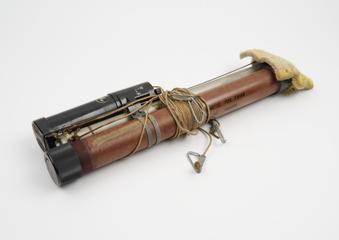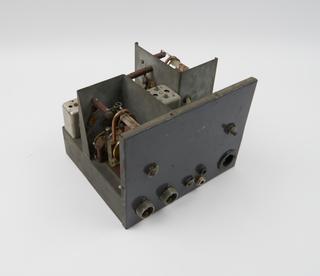
Type 268 marine radar wheelhouse indicator. The full Type 268 radar set consisted of: "cheese antenna" type antenna assembly with waveguide and horn; wheelhouse indicator (this object); power supply; and main console. The antenna was of the “Cheese antenna” type, 30-inches wide × 6.25-inches high, fed by waveguide and horn, not stabilized against pitch and roll. The transmitter used a magnetron of type 725A.
Type 268 was the first X-band (3cm) naval surface search, navigational and target-indication radar, for use on small vessels. It was developed and mostly (entirely?) manufactured by Canadian Arsenals Limited, Leaside, Ontario in Canada for the British Admiralty in 1944.
The primary purpose was to aid in the detection of surface craft or surfaced submarines with a relatively small range, depending on the size of the detected vessel, and to give fairly accurate information about their range and bearing. With fair visibility, moderate sea, and an aerial height of 25 feet (7.5 metres) above the waterline, E-boats should be detected at 6,000 yards (5.5km); trawlers at 12,000 yards (11km); and destroyers at 14,000 yards (12.8km). Aircraft could sometimes be detected if flying low.
The Type 268 could also be used to direct the blind fire of torpedoes at targets at short ranges and as an aid to navigation by determining coastal outlines. It was intended for use on motor torpedo boats and other small craft of the coastal forces.
The main design goal of this radar type was to locate U-boat schnorkels and the set permitted detection of a submarine snorkel at 3 NM; it also permitted detection of a battleship at 9 NM. When first developed, the RCN knew of the type 268 but its small antenna and resulting short range limited its value for escort work. The British were aware of the problem and had developed a larger, more powerful antenna for the system. This exclusively British development became the 972 set. Most of the 268 sets were fitted during the period 1945-52 and they were later replaced by the Decca Type 974. Since 1945 the radar was installed in coastal forces.
Details
- Category:
- Radar & Radio Location
- Object Number:
- 1949-56
- Measurements:
-
overall: 34.2 kg
- type:
- radar equipment
- credit:
- Board of Admiralty




